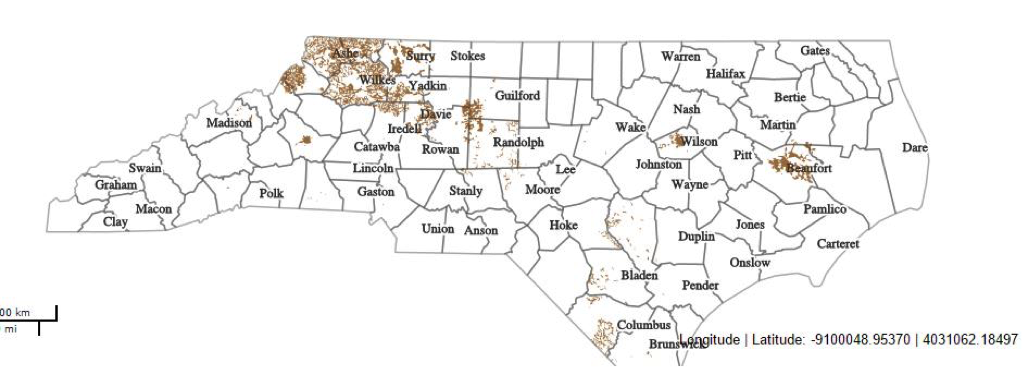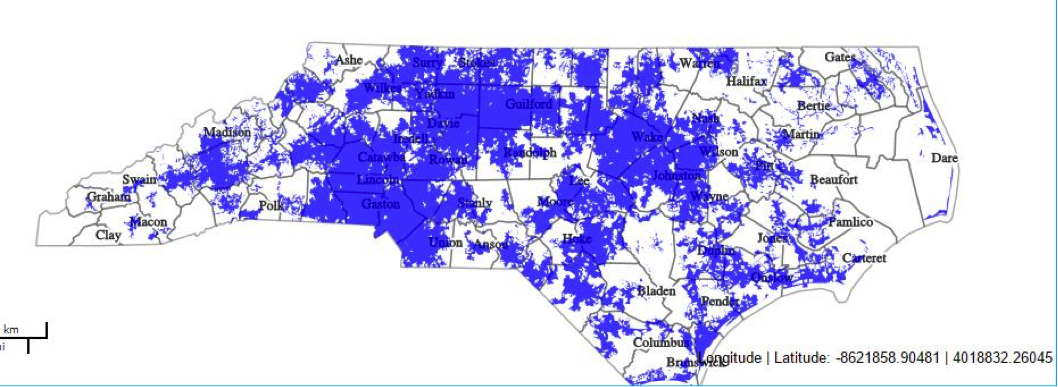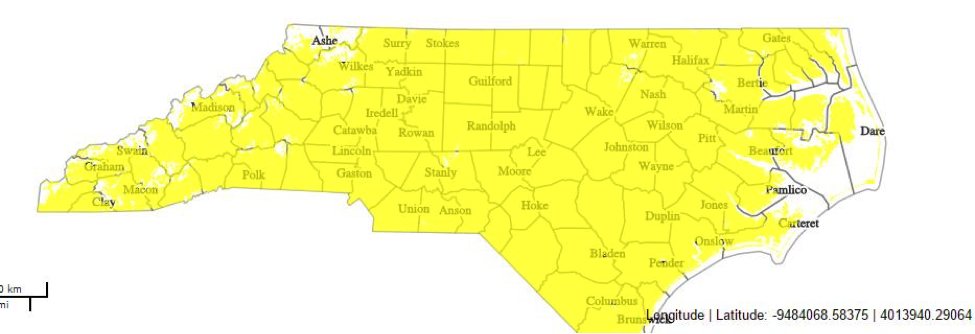In December, my colleague here at CELE, Brian Bowman, wrote an excellent piece about how technology can help make government more transparent and accessible. With data from the Pew Research Center, he then explored how often citizens are able to access government information on the Internet – and the many underserved groups who don’t yet receive the full benefits of technology (including older people, non-English speakers, and colorblind individuals).
In the spirit of helping us to further identify those problems in our own state, this post follows up with some specifics about North Carolina internet access, and how it impacts the people in our state. In addition to the underserved groups Brian mentioned, North Carolina sees a disproportionate impact in coverage among those living in rural areas, many of whom are older and are in significantly lower income brackets than those in metropolitan areas.
NC Broadband has a great new interactive map on its website that allows you to find coverage for a number of different internet resources by any location or district. The most immediately noticeable problem, for all types of coverage, is that it doesn’t go everywhere – not by a long shot. Fiber, the fastest source, is only found in about 15 of the 100 counties:
 NC Broadband Map: Fiber Coverage in North Carolina.
NC Broadband Map: Fiber Coverage in North Carolina.
Cable is much more widely available, but much slower, and dependent on traffic for its upload and download speeds – and as Brian pointed out, many people cannot afford the equipment and fees associated with accessing cable.
 NC Broadband Map: Cable Coverage in North Carolina.
NC Broadband Map: Cable Coverage in North Carolina.
But wait, you say – isn’t everyone accessing everything on a smartphone these days? This argument comes up often in conversations about how to provide internet access (particularly to rural areas). If people have smartphones, the thinking goes, then why worry about whether there’s internet coverage? They can just find the information on their phones!
As this new tool shows, though, even cell phone coverage isn’t everywhere yet:
 NC Broadband Map: Wireless Coverage in North Carolina.
NC Broadband Map: Wireless Coverage in North Carolina.
Although wireless coverage touches part of every county on this map, there are still dozens of pockets without cell coverage – and, in many cases, the map shows coverage in areas where only 3G service is available. (For people who live in rural areas, sometimes DSL is faster than 3G for loading media-rich, content-heavy web pages!)
In recent years, the NC Broadband Office has worked hard to raise awareness about the coverage issues in North Carolina, and to work with providers and infrastructure planning to leverage existing assets to complete “the last mile” of connectivity. We use the word “connectivity” in the context of access very often – but it’s important to remember that connectivity isn’t just how many lines there are or how many customers are online. Internet access connects people to resources, knowledge, and opportunities that go far beyond the borders of their own small community, and creates new connections through the medium of the internet. It is a powerful tool that can also be the basis for a more connected and inclusive community.
As we continue to debate and discuss better ways to improve transparency, build trust between governments and citizens, and engage our communities in public service, it’s important to remember that part of that work means advocating for and supporting creative solutions that bring technological access to all our citizens. We can also make small changes – like keeping our web pages and apps “light” so they are accessible in different types of coverages, or working with local institutions like libraries to make sure there are enough shared resources to meet demand and that training programs are available to those who need them. We can even encourage the communities we work with to access funding, technical assistance, and training to begin breaking down barriers to connectivity.
Hopefully, the next decade will bring enough support for these changes that we can finally connect that last mile – so that everyone can enjoy the same connections that many of us are fortunate enough to take for granted.
Emily – nice set of information and thinking about “the last mile” challenge. As you say, it is about outreach and equalizing access to data, images, information that more urban and well-to-do households often take for granted.
Can you point us to more guidance – for community groups and local governments who have websites, to “keep our web pages and apps “light” so they are accessible in different types of coverages”?
Hey John,
Thanks for the kind comments! There are a couple of ways we can “lighten up” our websites to make them more friendly to people without high-capacity internet access:
– Compress photos and images to minimum sizes. They won’t look much different, but it will save a lot of download time!
– Use the mobile optimization available from your content management system, like WordPress or Squarespace – usually, these will automatically change sites to be accessible from mobile devices, which prevents having to load the full web page on a mobile device.
– Slim it down: if a file or image isn’t necessary, don’t use it!
– Organize: Make sure menus are clear and the site is easy to navigate to prevent having to load multiple pages to reach a popular destination or page.
– Make sure your theme and overall design are clean and easy – and that you only use one and delete older ones. These can be data-heavy for mobile devices and for those accessing with lower download speeds.
Hope that’s helpful! I’m sure our IT gurus out there will have even more suggestions than this layperson does, too 🙂
Emily
Thanks for the article Emily. You are spot on when you talk about forgetting the pockets where people are not getting service. We get so wrapped up in our daily lives, that it’s easy to take coverage for granted… until we don’t have it.
Update: Our colleagues over at SOG’s Community and Economic Development blog have a great piece on the new federal program funding internet access in low-income areas. A good step towards the access problem…now let’s focus on the infrastructure problem! 🙂
http://ced.sog.unc.edu/connect-home-bridging-the-digital-divide/
I am looking to move into western North Carolina, but LTE and cable/fiber are a necessity for me to work at home. This article points out the disparity between the rural and the urban areas. I understand for the ISPs, there is an economy of scale, but everyone deserves the same availability.